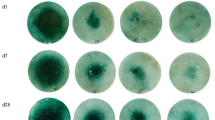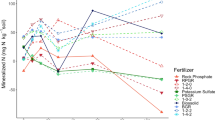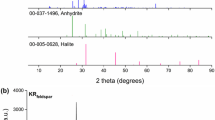Abstract
The aim of this work was to evaluate the Salamanca Formation greensands as an alternative potassium fertilizer to KCl. Glauconitic pellets from this formation tend to naturally concentrate in 600–250 μm (BS 250) and 250–125 μm (BS 125) fractions. After dry sieving and magnetic separation, these fractions were used for chemical, lixiviation, and specific surface analyses and agronomic evaluations. Two concentrated products were obtained: GL250c (600–250 μm) and GL125c (250–125 μm) representing 40.9 % of total sample. GL250c contains 2.97 % K2O, and GL125c contains 4.05 % K2O, representing 27 and 60 % increase in K-content compared to the bulk sample. Grain size of both concentrates decreased significantly through lixiviation tests. Potassium release curves from lixiviation waters show that K-liberation from GL250c was more effective in the first 15 days but decreased after that whereas liberation from GL125c continued to increase after 15 days probably due to higher K-content (36 % higher than GL250c). Specific area could have influenced liberation rates because after leaching it increased 27 % for the finer fraction and by only 16 % for the coarser one. From agronomic assays, measured over 75 days with five harvests, the first four harvests yield best results from KCl probably due to fast K-liberation rates from the salt. However, after overall harvests, fertilization efficiency using either GL250c or GL125c was very similar to and slightly higher than KCl fertilization. As equivalent results were found using either GL250c or GL125c, sieving to obtain these fractions seems not necessary. The results indicate that greensands from the Salamanca Formation are effective slow release alternative K source for fertilizers with low cost of production and treatment compared to operation costs required for mining K soluble salts at depth.







Similar content being viewed by others
References
Abd El Rahman, M. K. (2006). Degritting of glauconite clay by different techniques for use in water treatment and as fertilizer. Mineral Processing and Extractive Metallurgy, 116(8), 145–149.
Amazons Cerrado Verde Potash Project. (2012). A potash solution for Brasil’s growing potash problem. http://www.amazonplc.com.
Amorosi, A. (1995). Glaucony and sequence stratigraphy: A conceptual framework of distribution in siliciclastic sequences. Journal of Sedimentary Research, 65, 419–425.
Amorosi, A. (1997). Detecting compositional spatial and temporal attributes of Glaucony: A tool for provenance research. Sedimentary Geology Journal, 109, 35–153.
Amorosi, A., & Centineo, M. C. (1997). Glaucony from the Eocene of the Isle of Wight (southern UK): Implications for basin analysis and sequence-stratigraphic interpretation. Journal of the Geological Society, 154, 887–896.
Banerjee, S., Eevankumar, S., & Riksson, P. G. (2008). Mg-rich illite in marine transgressive and high stand system tracts: Examples from the Palaeoproterozoic Semri Group, Central India. Precambrian Research, 162, 212–226.
Castro, L. N., Fazio, A. M., Scasso, R. A., Tourn, S., & Soreda, M. E. (2008). Potential potassium deposits in Patagonia. Southeast of Argentina. Bulletin of the Tethys Geological Society (Bull. T.G.S.). Proceeding of Third International Conference on the Geology of the Tethys, 3, 275–280.
Castro, L. N., Scasso, R. A., Branzini, A., Zubillaga, M. S., Fazio, A. M., Tourn, S. M., et al. (2010). Los niveles glauconíticos de la Formación Salamanca. Chubut: su efectividad agronómica como fuente alternativa de fertilizante potásico de liberación controlada. Revista de la Asociación Geológica Argentina, 66(3), 391–398.
Castro, L. N., & Soreda, M. E. (2009). Evaluación de los niveles glauconíticos en la Formación Salamanca como recurso minero de aplicación industrial, Paleoceno inferior de la cuenca del Golfo de San Jorge, provincias de Chubut y Santa Cruz. Proceeding of 9° Congreso Argentino Geología Económica, 1, 159–164.
Castro, L., & Tourn, S. (2004). Direct application of phosphate rocks and glauconite as alternative sources of fertilizer in Argentina. SUM 21 special issue of Exploration and Mining Geology on sustainable development in the minerals industry. Geological Society of Canadian Institute of Mining. Metallurgy and Petroleum, 12, 72–79.
Chattoraj, S. L., Banerjee, A., & Saraswati, P. K. (2009). Glauconites from the Late Palaeocene–Early Eocene Naredi Formation, western Kutch and their genetic implications. Journal of the Geological Society of India, 73, 567–574.
Coles, S. K., Wright, C. I., Sinclair, D. A., & Van den Bossche, P. (2002). The potential for environmentally sound development of marine deposits of potassic and phosphatic minerals offshore, southern Africa. Marine Georesources and Geotechnology, 20(2), 87–110.
Dooley, J. H. (2006). Glauconite. In J. Koger, N. Trivedi, J. Barrer, & N. Krukowsky (Eds.), Industrial minerals and rocks: Commodities, market and uses (pp. 495–506). Littleton, CO: Society for Mining, Metallurgy and Exploration.
Folk, R. L., & Ward, W. C. (1957). Brazos River bar: A study in the significance of grain size parameters. Journal of Sedimentary Petrology, 27, 3–26.
Franzosi, C. (2009). Geología y evaluación de los recursos mineros para la agricultura del área del cerro Tortuga, Provincia del Chubut, Argentina. Final Geologist Grade Thesis, University of Buenos Aires (unpublished).
Hao, O. J., & Tsai, C. M. (1987). The removal of metals and ammonium by natural glauconite. Environment International, 13(2), 203–212.
Hassan, M., & El-Shall, H. (2004). Glauconitic clay of El Gidida, Egypt: Evaluation and surface modification. Applied Clay Science, 27, 219–222.
Heffer, P., & Prud’homme, M. (2013). Fertilizer outlook 2013–2017. In 81st IFA Annual Conference, Chicago, May 2013. http://www.fertilizer.org/HomePage/FERTILIZERS-THE-INDUSTRY/Market.
Kitamura, A. (1998). Glaucony and carbonate grains as indicators of the condensed section: Omma Formation, Japan. Sedimentary Geology Journal, 122, 151–163.
Levchenko, E., Patyk-Kara, N., & Levchenko, M. (2008). Glauconite deposits of Russia: Perspectives of development. MRD-07 Geology and mineral potential of CIS countries. In 33° International Geological Congress, Oslo. Abstract. http//:www.cprm.gov.br/33IGC/1259055.html.
Loveland, P. J. (1981). Weathering of a soil glauconite in Southern England. Geoderma, 25(1–2), 35–54.
McManus, J. (1988). Grain size determination and interpretation. In M. Tucker (Ed.), Techniques in sedimentology (pp. 63–85). Oxford: Blackwell.
McRae, S. G. (1972). Glauconite. Earth Science Reviews, 8(4), 397–440.
Odin, G. S., & Matter, A. (1981). De Glauconiarum Origine. Sedimentology, 28, 641–644.
Potash. (2012). Commodity statistics and information. United State Geological Survey. http://minerals.usgs.gov/minerals/pubs/commodity/potash/mcs-2012-potas.pdf.
Srasra, E., & Trabelsi-Ayedi, M. (2000). Textural properties of acid activated glauconite. Applied Clay Science, 17, 71–84.
TIFAC. (2009). Technologies for agricultural application of glauconite—A potash mineral. http://www.tifac.org.in/.
Tourn, S., Castro, L., Celeda, A., Scasso, R., Fazio, A., & Soreda, M. E. (2008). Mineralogía y geoquímica de las glauconías de la Formación Salamanca, Chubut, Argentina. Proceeding of 17° Congreso Geológico Argentino, Jujuy, 3, 910–912.
Wentworth, C. K. (1922). A scale of grade and class terms for clastic sediments. Journal of Geology, 30, 377–392.
Acknowledgments
The authors express their gratitude to the University of Buenos Aires, UBACYT 20020100100782 and BID 1728OC-AR-PICT 25342, Agencia Nacional de Promoción Científica y Técnica, projects from Argentina both directed by Dr. Roberto A. Scasso which provided partially the financial support to this research. We specially acknowledge the assistance given by Pan American Energy in the fieldwork. Finally, the authors want to thank very much the reviewers and the editor for the important comments that benefited the final version of this manuscript.
Author information
Authors and Affiliations
Corresponding author
Rights and permissions
About this article
Cite this article
Franzosi, C., Castro, L.N. & Celeda, A.M. Technical Evaluation of Glauconies as Alternative Potassium Fertilizer from the Salamanca Formation, Patagonia, Southwest Argentina. Nat Resour Res 23, 311–320 (2014). https://doi.org/10.1007/s11053-014-9232-1
Received:
Accepted:
Published:
Issue Date:
DOI: https://doi.org/10.1007/s11053-014-9232-1




